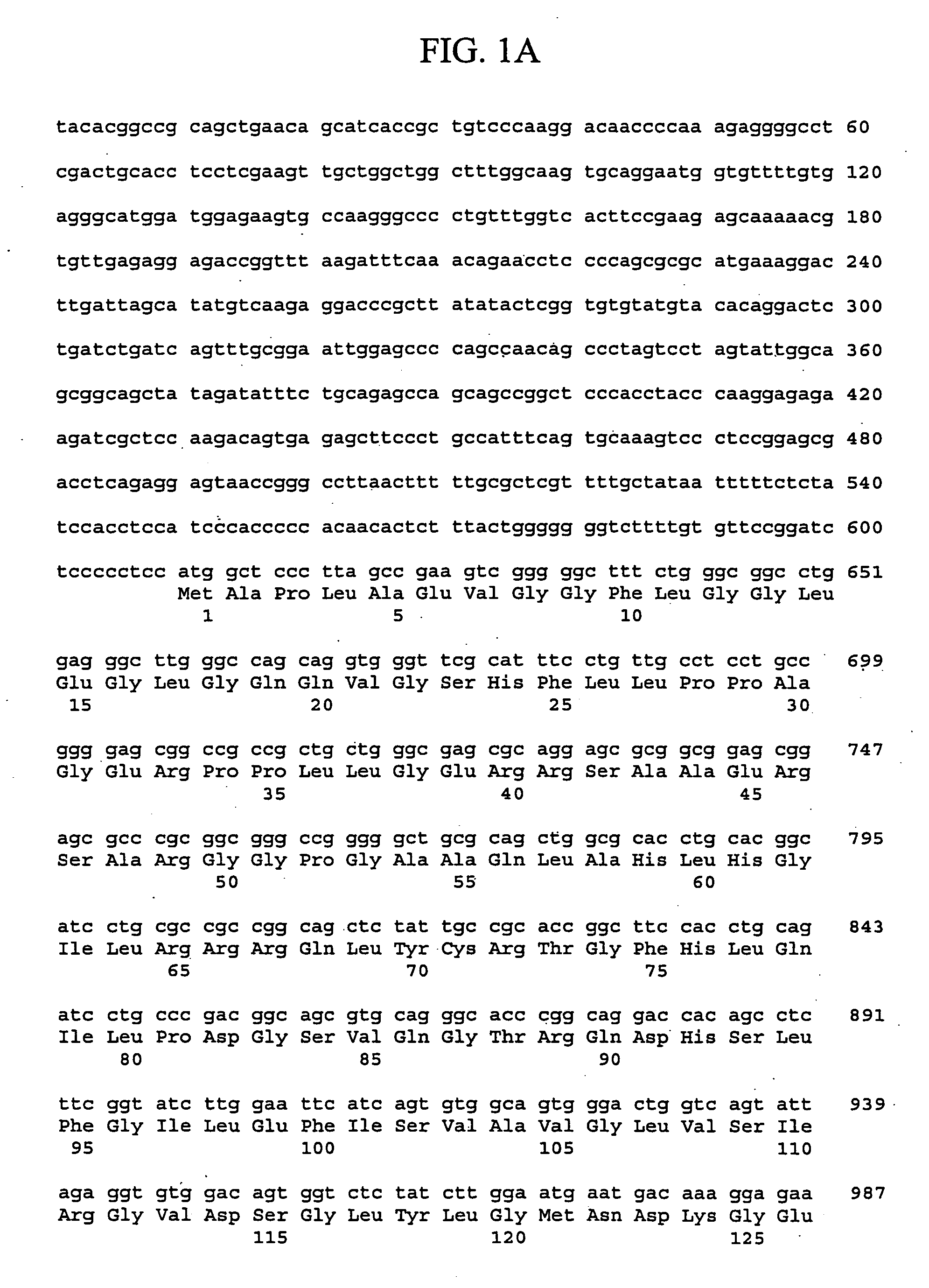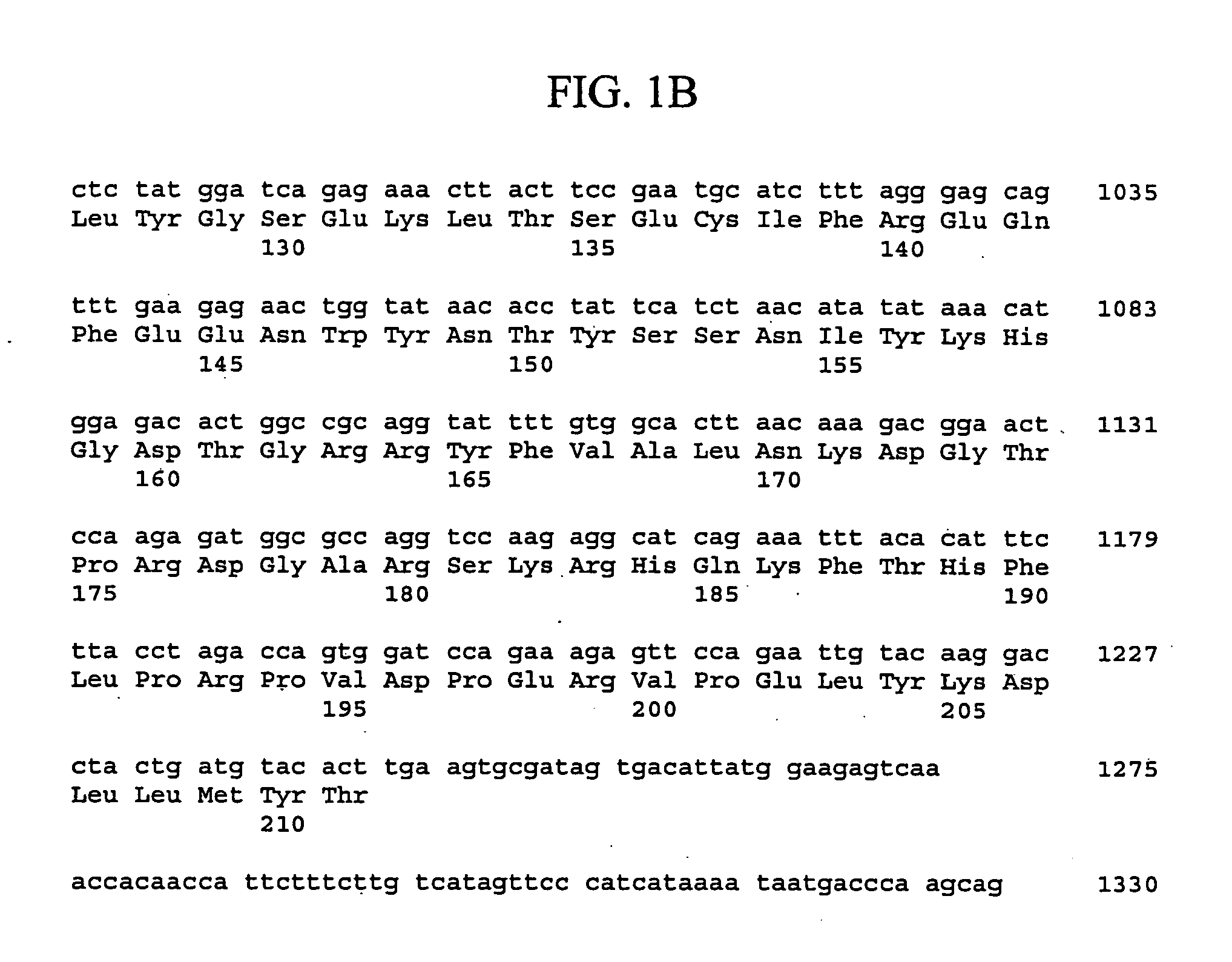Fibroblast growth factor-like molecules and uses thereof
- Summary
- Abstract
- Description
- Claims
- Application Information
AI Technical Summary
Benefits of technology
Problems solved by technology
Method used
Image
Examples
example 1
Cloning of the Human FGF-L Polypeptide Gene
[0313] Generally, materials and methods as described in Sambrook et al. supra were used to clone and analyze the gene encoding human FGF-L polypeptide.
[0314] A virtual transcript identified in a proprietary genomic database was used to isolate cDNA sequences encoding human FGF-L polypeptide. This virtual transcript was used to design gene specific oligonucleotides for the identification of cDNA sources and the generation of cDNA clones, using various PCR strategies.
[0315] The full-length cDNA sequence encoding human FGF-L polypeptide was obtained in arnplification reactions using a human fetal stomach cDNA library template and the amplimers 2440-39 (5′-C-C-A-T-G-G-C-T-C-C-C-T-T-A-G-C-C-G-A-A-G-T-C-3′; SEQ ID NO: 10) and 2432-77 (5′-T-C-A-C-T-A-T-C-G-C-A-C-T-T-C-A-A-G-T-G-T-A-C-A-T-C-3′; SEQ ID NO: 11). Reactions were performed at 94° C. for 2 minutes for one cycle; 94° C. for 45 seconds, 64° C. for 45 seconds, and 72° C. for 2 minutes fo...
example 2
FGF-L mRNA Expression
[0317] The expression of FGF-L mRNA is examined by Northern blot analysis. Multiple human tissue northern blots (Clontech) are probed with a suitable restriction fragment isolated from a human FGF-L polypeptide cDNA clone. The probe is labeled with 32P-dCTP using standard techniques.
[0318] Northern blots are prehybridized for 2 hours at 42° C. in hybridization solution (5×SSC, 50% deionized formamide, 5× Denhardt's solution, 0.5% SDS, and 100 mg / ml denatured salmon sperm DNA) and then hybridized at 42° C. overnight in fresh hybridization solution containing 5 ng / ml of the labeled probe. Following hybridization, the filters are washed twice for 10 minutes at room temperature in 2×SSC and 0.1% SDS, and then twice for 30 minutes at 65° C. in 0.1×SSC and 0.1% SDS. The blots are then exposed to autoradiography.
[0319] The expression of FGF-L mRNA is localized by in situ hybridization. A panel of normal embryonic and adult mouse tissues is fixed in 4% paraformaldehy...
example 3
Production of FGF-L Polypeptides
A. Expression of FGF-L Polypeptides in Bacteria
[0321] PCR is used to amplify template DNA sequences encoding an FGF-L polypeptide using primers corresponding to the 5′ and 3′ ends of the sequence The amplified DNA products may be modified to contain restriction enzyme sites to allow for insertion into expression vectors. PCR products are gel purified and inserted into expression vectors using standard recombinant DNA methodology. An exemplary vector, such as pAMG21 (ATCC no. 98113) containing the lux promoter and a gene encoding kanamycin resistance is digested with Bam HI and Nde I for directional cloning of inserted DNA. The ligated mixture is transformed into an E. coli host strain by electroporation and transformants are selected for kanamycin resistance. Plasmid DNA from selected colonies is isolated and subjected to DNA sequencing to confirm the presence of the insert.
[0322] Transformed host cells are incubated in 2×YT medium containing 30 μ...
PUM
| Property | Measurement | Unit |
|---|---|---|
| Fraction | aaaaa | aaaaa |
Abstract
Description
Claims
Application Information
 Login to View More
Login to View More - R&D Engineer
- R&D Manager
- IP Professional
- Industry Leading Data Capabilities
- Powerful AI technology
- Patent DNA Extraction
Browse by: Latest US Patents, China's latest patents, Technical Efficacy Thesaurus, Application Domain, Technology Topic, Popular Technical Reports.
© 2024 PatSnap. All rights reserved.Legal|Privacy policy|Modern Slavery Act Transparency Statement|Sitemap|About US| Contact US: help@patsnap.com










